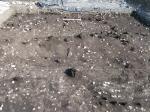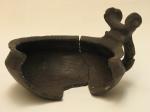Summary (English)
The 2012 campaign undertaken by the Università degli Studi di Milano concentrated on sectors D and E, where the latest occupation phases in the basin were examined. Only limited evidence of the full and final middle Bronze Age horizons emerging in these sectors had previously been documented at Lavagnone. In fact, these horizons had only previously been seen in heavily eroded surface levels by the north-western shore (sector B) and in a small trench towards the south-eastern shore.
Generally, there is little stratigraphic evidence in the entire Lake Garda area for these phases; therefore the present research could contribute to the formation of a more complete picture of population around the lake in the phases following the very well documented early Bronze Age. The context produced finds which establish a connection with the Padovan Terramare facies.The context in sector D (5 × 5 m) was anaerobic and heavily waterlogged due to the vicinity of the residual marsh. The investigation looked at a series of levels with a brown, peaty silt matrix containing abundant broken timbers and, sometimes having pottery fragments at the surface. In the westernmost part of the excavation area, the deposit sloped from east to west and was characterised by alternating layers of yellowish-grey coarse sand, rich in macro plant remains (cornel, acorns, blackberry….) and sandy-silt layers. The anaerobic conditions guarantee the optimal conservation of the organic finds and timber elements, many of which from posts. The heads of these posts were broken and heavily slanted, almost horizontal, while the real inclination of about 45° was documented in the layers below.
The intervention in sector E investigated an area of 64 m2, investigating a series of extensive stratigraphic contexts, constituted by an organic silt matrix containing large numbers of cobbles. The contexts also produced fragmented pottery still in situ and abundant faunal remains. A preliminary interpretation identified these contexts as material used for a land reclamation intervention.
As the excavation deepened, the deposit became anaerobic. In fact, at the end of the season the heads of numerous posts emerged from these peaty layers. The timber elements were sub-vertical or slightly leaning south to north and belonged to structures emerging from underlying levels not in phase with the exposed surfaces. Parallel alignments of these timbers were documented but their effective association can only be established by detailed dendrochronological analyses.
- Marta Rapi - Università degli Studi di Milano
Director
- Raffaele C. de Marinis - Università degli Studi di Milano
Team
- Adele Giuliano - Università degli Studi, Milano, CdL in Scienze dei Beni Culturali
- Alba Pasini - Università degli Studi, Milano, CdL in Scienze dei Beni Culturali
- Alfonsina Amato - Università degli Studi di Milano
- Alice Carri - Università degli Studi, Milano, CdL in Scienze dei Beni culturali
- Carmen Basile
- Claudia Marchelli
- Dario Sigari - Università di Ferrara
- Diego Veneziano - Università degli Studi di Milano
- Gian Paolo Spinelli - Università degli Studi, Milano
- Giuseppe Lorefice - Università degli Studi, Milano
- Leonardo Lamanna - Università degli Studi di Milano
- Manca Vinazza - Università degli Studi, Milano
- Mari Hirose - Università degli Studi, Milano, CdL in Scienze dei Beni culturali
- Elisa Ginoli - Università degli Studi, Milano
- Federica Porteri
- Andrea Tramelli - Università degli Studi, Milano, CdL in Scienze dei Beni culturali
- Cesare Ravazzi - CNR-I.D.P.A., Milano
- Renata Perego - CNR-I.D.P.A., Milano
- Candida Sidoli - Università degli Studi di Milano
Research Body
- Istituto per la Dinamica dei Processi Ambientali del C.N.R di Dalmine (BG)
- Università degli Studi di Milano, Dipartimento di Beni Culturali e Ambientali
Funding Body
- Università degli Studi di Milano






![Download [PDF]](/excavation/skins/fasti/images/results/download_sml.png)
